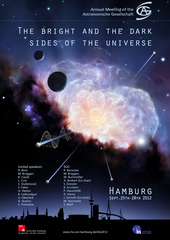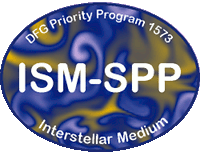DFG Priority Program 1573
Physics of the Interstellar Medium
Splinter session
Annual Meeting of the Astronomische Gesellschaft,
Hamburg, September 24-28, 2012
 The DFG priority programme 1573 "The Physics of the Interstellar Medium" was newly established at the end of 2011 and was ment
to focus the effort of the German research community in the field of the interstellar medium. The aim of this splinter session
is to start a series of meetings to bring together scientists who address similar problems of ISM research with various techniques:
observations, laboratory experiments and simulations. We will reserve ample time for discussion on how to combine these various
findings in order to create a consistent picture of the most important physical processes of the turbulent ISM.
The DFG priority programme 1573 "The Physics of the Interstellar Medium" was newly established at the end of 2011 and was ment
to focus the effort of the German research community in the field of the interstellar medium. The aim of this splinter session
is to start a series of meetings to bring together scientists who address similar problems of ISM research with various techniques:
observations, laboratory experiments and simulations. We will reserve ample time for discussion on how to combine these various
findings in order to create a consistent picture of the most important physical processes of the turbulent ISM.
If you have any questions, please contact:
Dates:
Tuesday, September 25, 14:15 to 18:15
Wednesday, September 26, 14:15 to 18:15
Location: Hörsaal A / Auditorium A
Important links:
Program
A PDF version of the program can be found here.| Tuesday, September 25th, 2012 | |||
| Molecular Clouds and Star Formation (Chair: Stefanie Walch) | |||
| 14:15 | Markus Nielbock | B68 - The HERSCHEL view: dust temperatures and densities | |
| 14:30 | Kalevi Mattila | Spectrophotometry of a high-latitude dust cloud: scattered light, ISRF and the Extragalactic Background Light | |
| 14:45 | Jouni Kainulainen | Dependence of density variance with sonic Mach number in molecular clouds | |
| 15:00 | Hua-bai Li | The Link between Magnetic Fields, Filamentary Clouds and Star Formation in the Gould Belt | |
| The Local ISM (Chair: Roland Diehl) | |||
| 15:15 | Roland Diehl | ISM Measurements in the Galaxy through Radioactivity Gamma-Rays | |
| 15:30 | Benjamin Gaczkowski | Deciphering the interstellar medium around the Scorpius-Centarus OB association | |
| 15:45 | Katharina Fierlinger | Feedback efficiency in windblown bubbles | |
| 16:00 | Stefanie Walch | The impact of feedback from massive stars on the interstellar medium | |
| 16:15 | Coffee / Tea Break and Poster Viewing | ||
| 16:45 | Jan Bolte | Hydrodynamical Simulations of the Young Supernova Remnant CTB 109 | |
| 17:00 | Michael Schulreich | Investigating the link between an iron-60 anomaly in the deep ocean's crust and the origin of the Local Bubble | |
| 17:15 | Alessandro Ballone | A numerical study of stellar winds in extremely different ambient media | |
| 17:30 | Marc Schartmann | Simulations of the origin and fate of the Galactic Centre cloud G2 | |
| Gas and Dust Chemistry I (Chair: Marc Schartmann) | |||
| 17:45 | A. Beate C. Patzer | Small molecular titanium carbide clusters as dust precursors at low metallicity conditions | |
| Wednesday, September 26th, 2012 | |||
| Gas and Dust Chemistry II (Chair: Marc Schartmann) | |||
| 14:15 | Florian Kirchschlager | Blowout size of porous dust grains | |
| 14:30 | Stefano Bovino | Complexity reduction of astrochemical network | |
| The Local ISM (addendum) (Chair: Marc Schartmann) | |||
| 14:45 | Matthias Gritschneder | Triggered Star Formation - From the Pipe Nebula to our own Solar System | |
| The Milky Way Halo (Chair: Andreas Burkert) | |||
| 15:00 | Nadya Ben Bekhti | The distribution of gas in the halo of the Milky Way | |
| 15:15 | Peter Herenz | The Milky Way halo as QSO absorption-line system | |
| 15:30 | Verena Lüghausen | Towards a revised picture of Compact High-Velocity Clouds: New Results from EBHIS and GASS | |
| The ISM beyond the Galaxy (Chair: Andreas Burkert) | |||
| 15:45 | Tobias Röhser | Far-infrared deficient and molecular intermediate velocity clouds | |
| 16:00 | Peter Kamphuis | The ISM in the Halos of Spiral Galaxies | |
| 16:15 | Coffee / Tea Break and Poster Viewing | ||
| 16:45 | Pierre Voigtländer | A kinematical study of the ionized gas in NGC 4666 | |
| 17:00 | Martin Wendt | Molecular Hydrogen at high redshifts - a rare tracer of physical conditions and constants | |
| 17:15 | Muhammad Latif | The implications of dust for high-redshift protogalaxies and the formation of binary disks | |
| Cosmic Rays and Magnetic Fields (Chair: R. Schlickeiser) | |||
| 17:30 | Björn Adebahr | M82 - Cosmic ray propagation and magnetic fields | |
| 17:45 | Jennifer Schober | Magnetic Fields in the Primordial ISM | |
| 18:00 | Reinhard Schlickeiser | Cosmic magnetization: from spontaneously emitted aperiodic turbulent to ordered equipartition fields | |
 This priority program is funded by the German Research Foundation DFG.
This priority program is funded by the German Research Foundation DFG.
